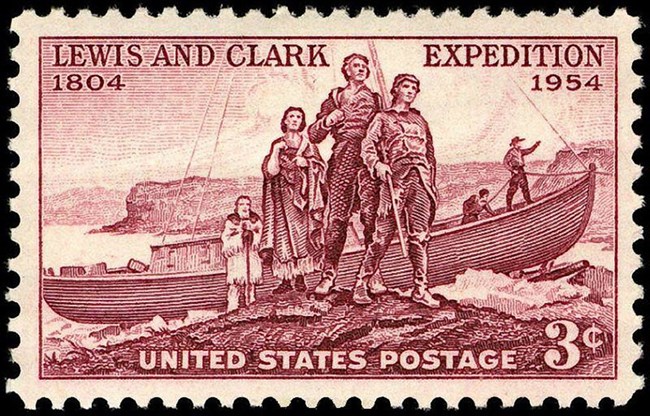Last updated: March 19, 2018
Article
The Return

US Postal Service
On March 23, 1806, the return trip began. They followed the Columbia River upstream and eventually bought some pack horses to carry their gear until they reached the Nez Perce to retrieve their horses. From May 14 to June 10 the Corps stayed at a camp as guests of the Nez Perce and waited for the snow to melt.
On June 30, they were able to reach Traveler’s Rest (Near today’s Missoula, Montana). From here, the party split to gather more data and ensure that they hadn't missed an easier route to the Pacific. Lewis went north to explore the Marias River while Clark went south to the Yellowstone River. They planned to rendezvous where the Yellowstone and Missouri rivers come together in western North Dakota.
During this separation, part of Lewis's group had a violent encounter with a small group of Blackfeet (Pikuni) at what is now Two Medicine Fight Site. This was the only violent incident of the entire journey.
After the Corps reunited in North Dakota they returned to the Mandan villages. Charbonneau, Sacagawea and Pomp remained while the others continued down the Missouri River. The Corps returned to St. Louis on September 23, 1806 and disbanded. Descriptions of the journey, maps, and collected specimens were sent to the American Philosophical Society and later the Academy of Natural Sciences in Philadelphia.
Lewis and Clark made their way east. They stayed at Locust Grove, the home of Clark's sister, for three weeks before going to Washington, D.C. While in D.C. they met with President Jefferson to recount the experiences of the expedition.
Both Lewis and Clark received rewards for their work. Clark was appointed Indian agent at St. Louis, and five years later became Governor of the Missouri Territory. President Monroe appointed him Superintendent of Indian Affairs to establish and secure treaties with western tribes. He died in St. Louis in 1838 and is buried at Bellefontaine Cemetery.
Lewis became Governor of the Louisiana Territory. He had difficulty in this role, most notably in the public perception of how he spent official government funds. In 1809 he was traveling to Washington, D.C., to account for his use of funds. On October 11 he died en route from two gunshot wounds - one to his head, the other to his chest. It is commonly believed that he committed suicide. He was buried near Grinder’s Stand along the Natchez Trace Parkway, where a monument stands in his honor.
Sources:
This is an updated excerpt from The Journey and Others Who Made the Journey from the Jefferson National Expansion Memorial's Lewis and Clark Journey of Discovery website.
http://www.pbs.org/lewisandclark/inside/saca.html
https://www.nps.gov/nepe/planyourvisit/upload/2008%20Lewis%20and%20Clark.pdf
Tags
- natchez trace parkway
- nez perce national historical park
- travel lewis clark
- lewis clark
- expedition
- history
- heritage
- travel itineraries
- national register of historic places
- meriwether lewis
- william clark
- sacagawea
- corps of discovery
- westward expansion
- st. louis
- philadelphia
- missouri river
- nez perce
- louisiana territory
- natchez trace parkway
